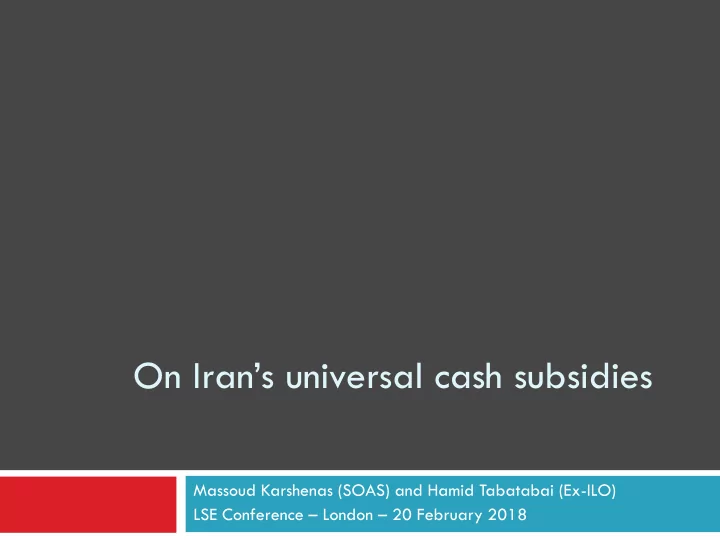

On Iran’s universal cash subsidies Massoud Karshenas (SOAS) and Hamid Tabatabai (Ex-ILO) LSE Conference – London – 20 February 2018
Purpose 2 To present Iran’s nationwide cash subsidy scheme (genesis, impact, prospects and lessons). Launched in Dec 2010, the scheme consists of paying all Iranians a fixed amount of cash, 455,000 rials / person, each month (at the time eq. to $45 / person; 2/3 minimum wage / household of average size) Cash subsidy is not a Universal Basic Income (UBI) Shared features: paid by the government, universal, unconditional, regular, same amount to all citizens. Main differences: not meant as UBI, not sufficient to cover basics, paid to HH head for all HH members.
Genesis (1): Subsidy reform 3 Scheme devised as compensation to win popular support for reform of massive price subsidies. Subsidised items: Fuel, electricity, water, bread Pre-reform give-away prices: petrol 10 US cents / litre; diesel under 2 cents; ... Annual subsidy bill: $100 billion (mostly on energy) Subsidy system being: Inefficient: wasteful consumption, pollution, smuggling to neighbouring countries, etc. Costly: rapidly rising bill Unfair: 70% going to richest 30% of the population
Genesis (2): Cash compensation 4 Grand idea: Replacing price subsidies with cash subsidies to HHs, enterprises, infrastructure dev. Initial plan: Target 70% of population (below mean national income) using demographics, education, income, car & house ownership, bank loans! HH (mis)classifications caused widespread discontent Targeting abandoned in favour of universality (with plea to the well-off to voluntarily abstain!) Coverage eventually rose to a peak of 96% of population (74 million at the time) Law passed in 2010; Implemented in Dec. 2010
Impact (1) 5 Methodological difficulties in assessing impact of a universal programme (lack of control groups, many intervening factors, …). Easily discernible effects: Established right to universal cash benefits Established a nationwide constituency that resists roll-back Novel funding mechanism (higher energy prices rather than government budget, in theory!) Spread banking services throughout the country (monthly cash subsidies are deposited automatically in bank account of HH heads) Roll-out handled smoothly (confirming implementation capacity) Loss of 70% of purchasing power over the 7 years of programme due to inflation (no change in nominal transfer, see Table)
Trends in cash subsidy per person: nominal and real indices, 2010-2017 6 Cash subsidy Urban CPI Cash subsidy real Year nominal index (fixed (2016=100) index (2010 =100) amount throughout) 2010 33.2 100.0 100.0 2011 40.3 100.0 82.4 2012 52.6 100.0 63.1 2013 70.9 100.0 46.8 2014 81.9 100.0 40.5 2015 91.7 100.0 36.2 2016 100.0 100.0 33.2 2017 110.0 100.0 30.2
Impact (2) 7 Some tentative conclusions based on available studies: More analytical impacts: Energy consumption: Only short term impact (the reform process weakened over time) Poverty: Most likely positive Income distribution: Most likely positive labour supply (conflicting accounts) Presumed pressure on government budget, already battered by sanctions, as transfer amount had been set too high relative to extra revenues from higher prices (for both political and practical reasons)
Prospects (1) 8 Although very popular, political class and experts generally against the scheme. Among reasons advanced: Drain on government resources Preferred alternatives for use of resources (health, education, infrastructure, etc.) Little justification for universality (why pay the rich?) Promotes a culture of hand-outs Ex- president Ahmadinejad (scheme’s initiator) now politically ostracised “Solution” sought: Target “the needy”, with possibly larger transfer amount. “Solution” in practice: Inflation (70% loss of transfer value in 7 years)
Prospects (2) 9 Lukewarm attempts at targeting so far Dropping 5 million out of 75 million, but 1.5 million (30%) restored after complaint In 2016, 840,000 dropped but 60% restored More recent exclusions beset with more errors Further exclusions may affect over 30 million Criteria for further exclusions: Not specified yet, but confusing leaks and confused discussion
Lessons 10 What accounts for the emergence of world’s largest universal cash transfer scheme? Not labelled as UBI (a concept virtually unknown in Iran) Identified as part of solution of a widely acknowledged problem (price subsidies) Novelty of funding mechanism Systematic preparation and information dissemination Weakening the scheme: Poor arithmetic, turbulent environment (international sanctions), exceedingly politicised
11 Thank you
Recommend
More recommend